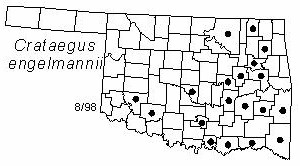Small tree to 6 m (20 ft) in height and 15 cm (6 in) in diameter. Crown broad, spreading with a flat top. Twigs light brown, with large lenticels, white pubescence on young stems, becoming glabrous with age; spines slender, about 5 cm (2 in) long. Leaves alternate, simple, reverse-ovate to elliptical, 2.5-3.8 cm (1-1.5 in) long and 1.3-2.5 cm (0.5-1 in) wide, with short stiff hairs above, pilose hairs above and beneath on the midrib; rounded or short-pointed at apex, margins glandular-serrate with incurved teeth; lustrous dark green above, paler below; petioles short, glandular pilose. Flowers 8-12 in cymes, with long pale hairs, about 2 cm (0.75 in) long, tomentose, villose, or nearly glabrous; petals 5, white; styles 2-3; stamens 10; flowers appear from April to May. Fruits pomes, about 8 mm (0.3 in) diameter, globose, orange-red; 2-3, thick and prominently ribbed; fruits mature in November.
Distribution: East Texas, Oklahoma, Kansas, Missouri, Arkansas, east to Tennesse, Kentucky, Alabama. Mississippi, and Illinois. Uncommon in Oklahoma.
Habitat: dry hillsides on limestone soil.
Comments: Crataegus is from the Greek meaning "flowering thorn"; the specific epithet honors George Engelmann (1809-1884), a German-born physician and botanist in St. Louis.
Field identification: Engelmann's hawthorne is closely related to barberry hawthorn C. berberifolia, but can be distinguished by its large lenticels.
Wildlife benefits: In general, the fruits of hawthorn species are eaten by several species of birds. The dense branching pattern provides shelter and nesting habitat for several species of birds.
NWI status: none
Distribution in Oklahoma: 
BACK
NEXT
RETURN TO INDEX
Last update: 9/9/99
 Go to Oklahoma Biological Survey Home Page
Go to Oklahoma Biological Survey Home Page
 Disclaimer
Disclaimer